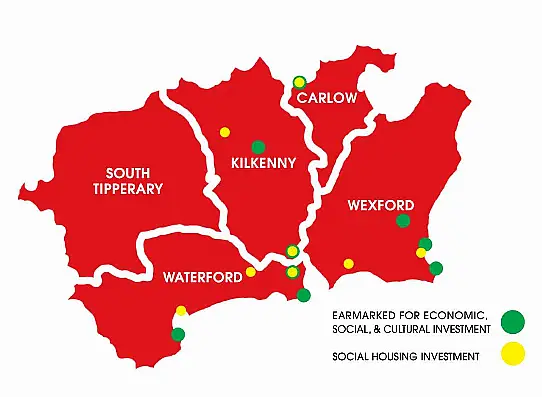Project Ireland 2040 is a strategic policy initiative to create a better Ireland. An Ireland that will flourish despite pressure from a growing population, a larger economy and a changing climate.
This content is brought to you by Project Ireland 2040, an initiative of The Government of Ireland.
Despite 10% of Irish people calling it home, the South East region was one of the worst affected by the last recession. As recently as 2016, researches at Waterford Institute of Technology characterised the South East as having “persistently high levels of unemployment, deprivation and significantly lower job quality in comparison with other regions.”
Ireland 2040 seeks to overturn this by looking to the short, medium and long-term future of the South-East region – including Ireland as a whole.
It’s an ambitious blueprint that seeks to turn our post-recession investment as one of the lowest in Europe to among the highest.
In all, €116 billion will be invested, divided between €91 billion in exchequer funding and a further €25 billion from state-owned commercial companies.
Ireland 2040’s multi-faceted approach will see investment supported by three pillars: social, economic and cultural. For this to work, effective planning will be needed to ensure that the Ireland twenty-two years from today is one equipped for fresh demands.

Locations Earmarked for Development
But, what’s in store for us?
The government expects the South East’s largest urban centre, Waterford, to expand by 50% over the next 22 years. Because of this, Waterford sits at the heart of the Government’s plans for the South East.
The focal point of this is the designation of Ferrybank’s North Quays as a Strategic Development Zone (SDZ). Investment allocated to this small strip
along the banks of the Suir will see the area transformed into a nucleus of economic, social and cultural activity.
Bitesize Fact: There are 3,500 additional social homes planned for the South-East region.
A new Technological University for the South East (TUSE) will feed world-class graduates into Waterford’s SDZ and surrounding environs.
With this, improvements will come in the provision of public transport where commute times to, from and within Waterford will be reduced. Air travel will also benefit, with Waterford Airport to benefit from guaranteed funding.
A greying population will see a need for improved healthcare services. Increased capacity and a new palliative unit at University Hospital Waterford will play their part in aiding ease of access to a population in transition.
But it’s just not Waterford that will benefit from the 2040 vision. The Government recognises the South East as being characterised by a strong network of market towns. These towns will play a key role in developing and optimising crucial opportunities that the vision is built on.
Bitesize Fact: Ferrybank’s North Quays is listed as a Strategic Development Zone (SDZ).
To ensure balanced economic growth, rural areas will be supported by a host of initiatives, including the Town & Village Renewal Scheme and the RAPID programme.
Social housing in these regional towns and villages will receive attention, with 3,500 additional homes planned for the South-East region.
A proposed National Food Innovation Hub and a Prepared Consumer Food Innovation Hub for the South East is set to foster a supportive environment for those working in the farming and food-science sectors.
Bitesize Fact: Waterford is set to expand by 50% in the next 22 years.
Places of cultural importance will also receive attention, with the Irish-speaking Gaeltacht na nDéise benefitting from a job creation investment.
Feeding these local economies will be Rosslare Europort and Bellview Port, which will receive investment to enable greater connectivity to Europe - opening the South-East region to international connectivity.






